I’m Milo, a Museum Studies student on placement here at GWL. It’s been a joy getting to know the GWL Poster Collection, and it’s my pleasure to share some snippets of this experience with you all.
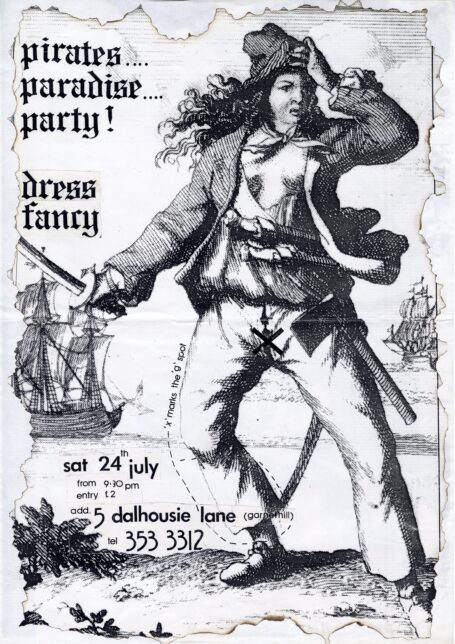
The category of ‘Poster’ is a little narrow for the range of materials I’ve come across – from hardback fashion publications, to a few hundred charcoal drawings, from mass-produced posters to handcrafted collages. It’s not all oversize either; there are lots of flyers, especially among the subset of the collection that originates from GWL’s own history, and its precursor Women in Profile. As well as cataloguing the posters, my placement is focussed on detailing and digitising materials from GWL’s history. After recording some 1342 items, I switched tracks to digitising instead of cataloguing. That’s not all of the collection: its extent still remains to be documented, and while I hope to at least have some kind of finished list of items by the end of my placement, there are probably more posters lurking in hidden nooks of the archive that’ll show up long after I’ve left.
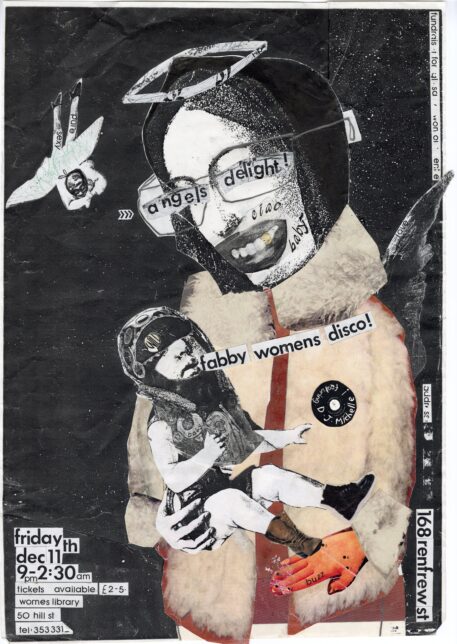
The non-GWL material is incredible in its own right, and if it weren’t for my time constraints I would be absorbed into the histories of various lesbian support groups of the London boroughs in the late 80s, the actions at Greenham Common, the women on the picket lines at Grunwick, the list goes on. The flippancy of some the event promotions is delightful, from the Lock Up Your Daughters lesbian dance party to the Silly Bitches Disco. A reminder that we’ve always needed to inject some humour and not take ourselves too seriously to survive and thrive. As much as I would love to research and tell you all about the materials that GWL has received over the years (many from the Lesbian Archive), I have had to resist my own curiosity to focus on GWL’s own history, and the Three Decades project.
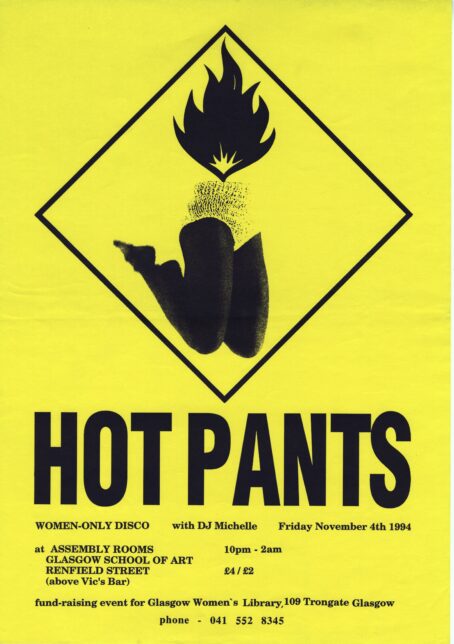
If there’s an upside to the financial constraints grass-roots organisers are subject to, it’s the resulting tendency to produce materials small enough to fit in a flatbed scanner. There are a few very interesting items that will need to be photographed with a digital camera, and I’m excited for when those can be shared with the world, but for now I’ve managed to digitise a respectable 58 posters and flyers that have as yet not been committed to computer memory. They’re a mix of GWL and Women in Profile, with many originating in the archivally-awkward overlap in the early 90s, where both organisations are listed on posters and flyers for a few years. Several design themes become immediately obvious. Many of the earlier materials are collaged, whether it’s a piratical fancy dress party (fig. 1) or a fabby disco (fig. 2). We have the original collages for several of these designs, many of which are starting to come apart as the adhesives finally give in after thirty odd years. Not to worry though, that’s what archival sleeves and brass paper-clips are for.
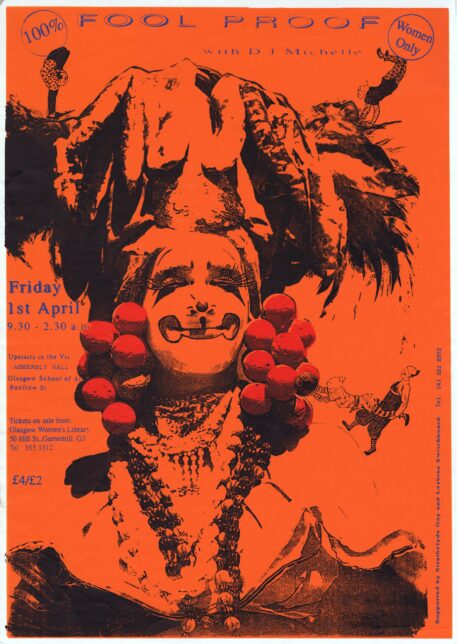
Another common thread of design is the use of orange and yellow. Many materials are printed and designed in black and white or greyscale – colour ink is expensive – but the posters for several fundraisers such as the Mayhem (fig. 3) and Hotpants (fig. 4) events are printed onto lurid yellow and orange, sure to catch the eye a mile off. This survives through to later events like 100% Foolproof (fig. 5) where designs are now in full colour and making the most of it.
Aside from the bold visuals, which are very in-keeping with the history and ethos of GWL, there is another reason behind this choice, a story told in part through an A4 sheet of paper. Assembled on this paper is a collage on both sides, repeating the same thing four times. These were intended to be flyers, though this quartet were never separated, for an archive in Nuremberg: Die Kuenstlerinnenarchiv (The Women Artists’ Archive). From what I can tell, the organisation on its own no longer exists, but its records seem to be held by Nuremberg’s city archives. These flyers (fig. 6) were housed in a plastic pocket, accompanied by a sheet of paper addressed from Nuremberg, posted to Glasgow (which is twinned with Nuremberg). The early organisers of Women in Profile developed a relationship with Die Künstlerinnenarchiv, apparently visiting several times. These flyers, which provide information in English about the work of Die Künstlerinnenarchiv, were provided to, or possibly made by, Women in Profile to give to their community in Glasgow and forge a link between the two organisations. Women in Profile took aesthetic inspiration from Die Künstlerinnenarchiv, in particular their use of orange.
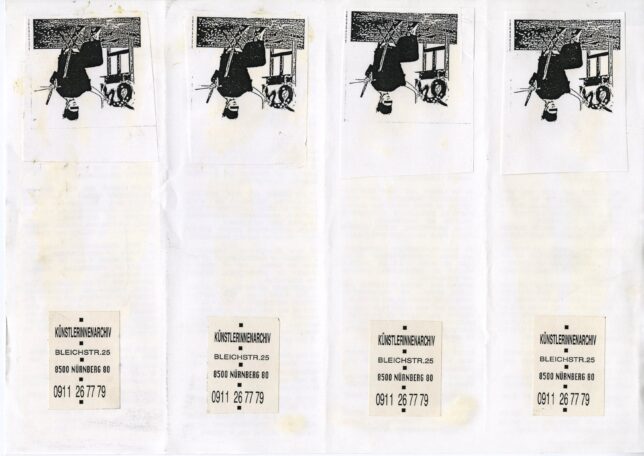
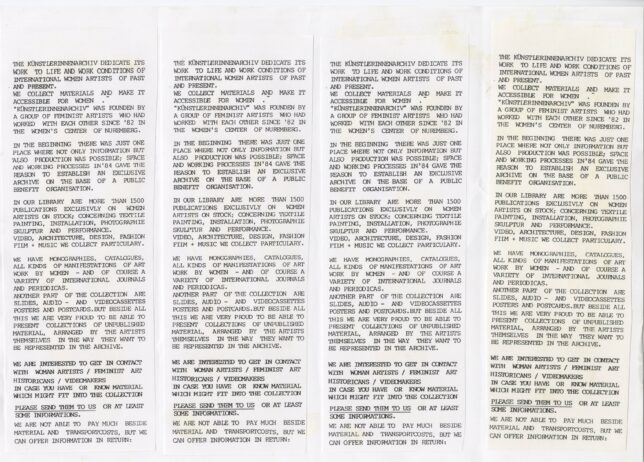
Aesthetics aside, learning the story of this connection was really inspiring. All of the materials produced by GWL and Women in Profile are proof of their work in building and sustaining a community committed to feminist organising, but seeing these connections and bonds reach out internationally, before the rise of global social media and the internet as we know it now is getting to glimpse something incredibly special. It is a story I will take with me after my placement into future organising work, a reminder of the strength of community and the necessity of the work that builds and sustains it.
The methodology or way of knowing stories are what archive work is all about for me. We have all these record codes, call numbers, filing hierarchies, and those can be really depersonalising and removed from the human lives that we are keeping records of. As I see it, to take any sort of ethical approach to archival work is to invest yourself in the personal side of it and to do your best to contextualise the archival material you have in order to communicate the stories of the people and communities your archive documents. Who were they? What did they feel? I am lucky to be on placement at an organisation like GWL that by its organisational nature is deeply interested in the personal and in local community and history. Being here makes me feel deeply connected to a feminist organising tradition and history in a way that it is pretty rare to feel connected to something these days for me. That is what archives at least in theory have the potential to do, to allow us to know our history.
Another story that emerges in these materials, one that is still mysterious to me, is that of DJ Michelle, a prolific figure across GWL fundraisers in the 90s. You might have spotted her name on some of the posters included in this article. If it’s to raise money for GWL, she will be there. So who is DJ Michelle? Was she a DJ first and a GWL supporter second, or is this a committed Women in Profile/GWL feminist organiser who also had some skills on the decks? From only the name DJ Michelle, in Glasgow in the 90s, I’ve had no luck researching. I’ll have to flag down someone who was at one of those events at some point and ask if they remember. DJ Michelle, if you’re reading this, I hope you’re having a good day.

This video is licensed under a Creative Commons Attribution 4.0 International License.

One reply on ““A community committed to feminist organising” Milo blogs about archiving our poster collection”
DJ Michelle was a star – she’s Michelle Mangan – @djmishmish
Also, I made the ‘100% Fool Proof’ poster – I silkscreened it at Glasgow School of Art when I was a printmaking student there!